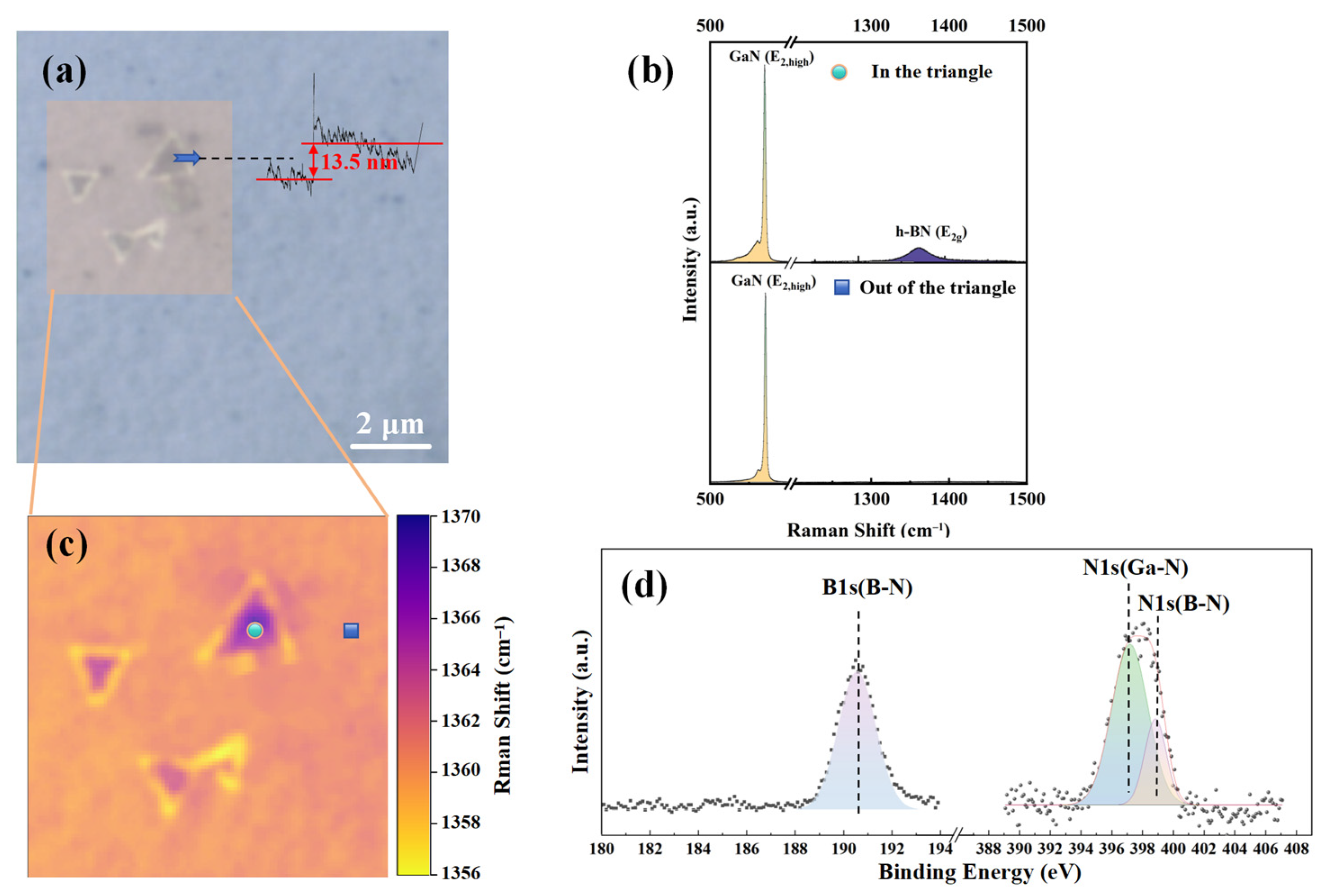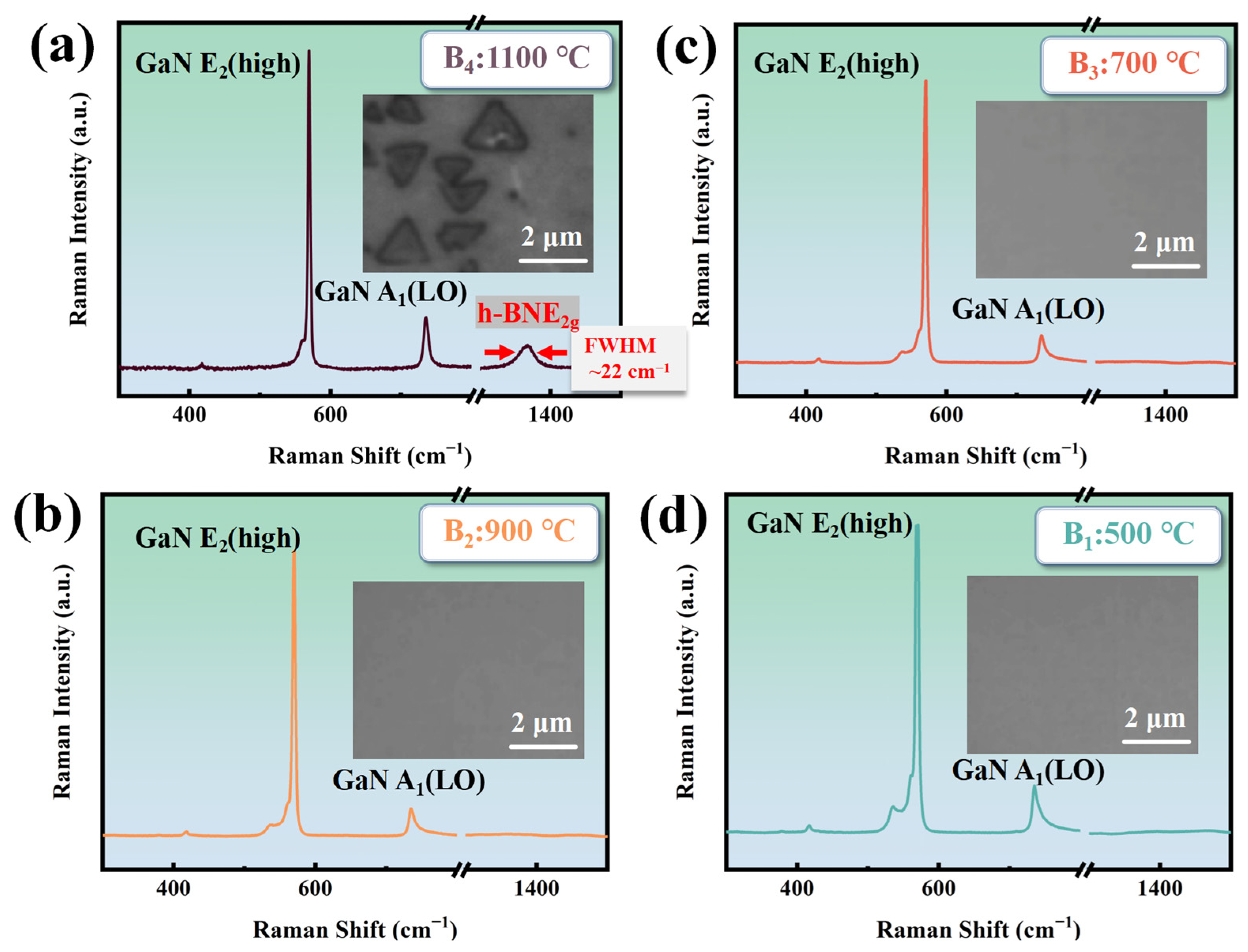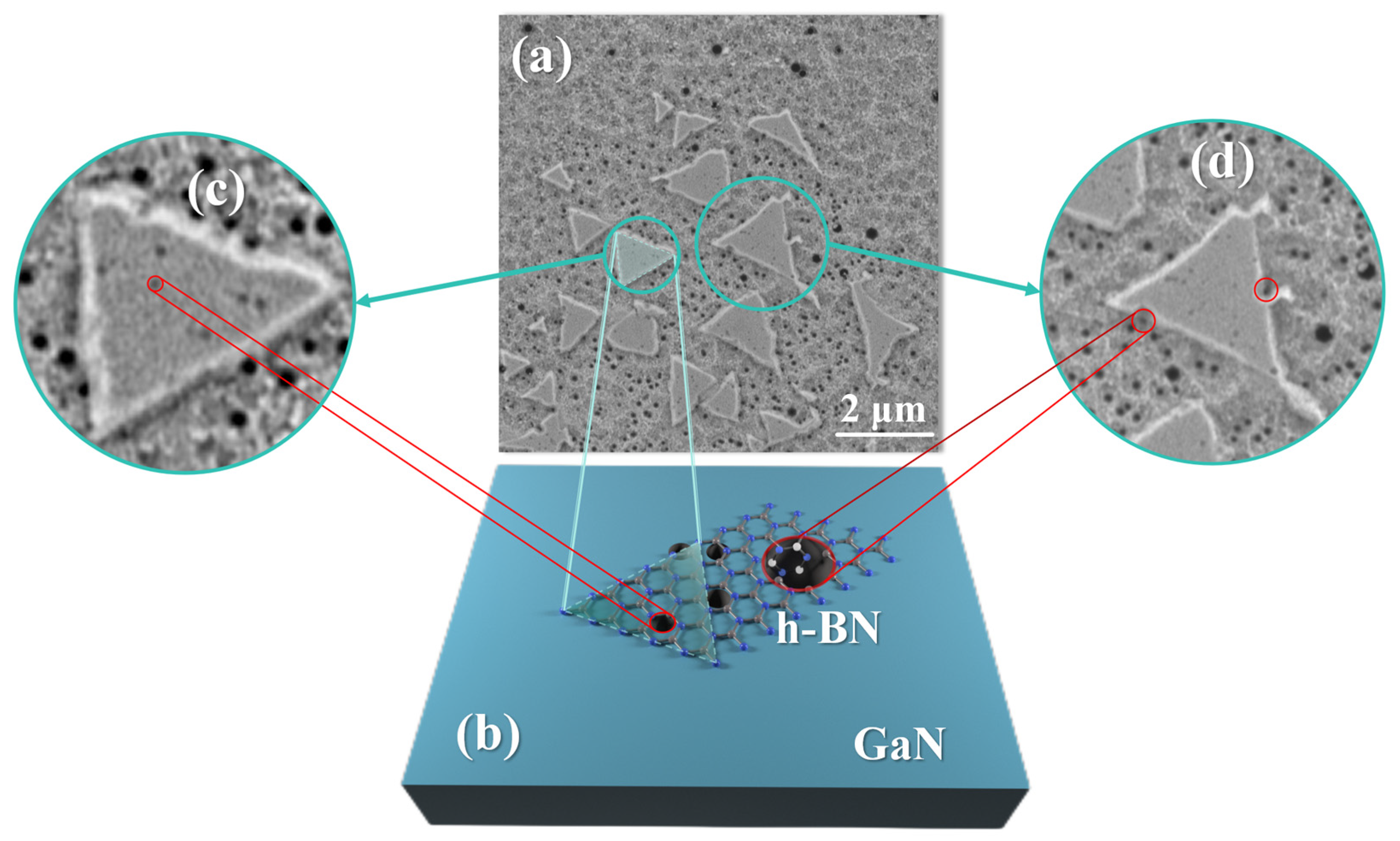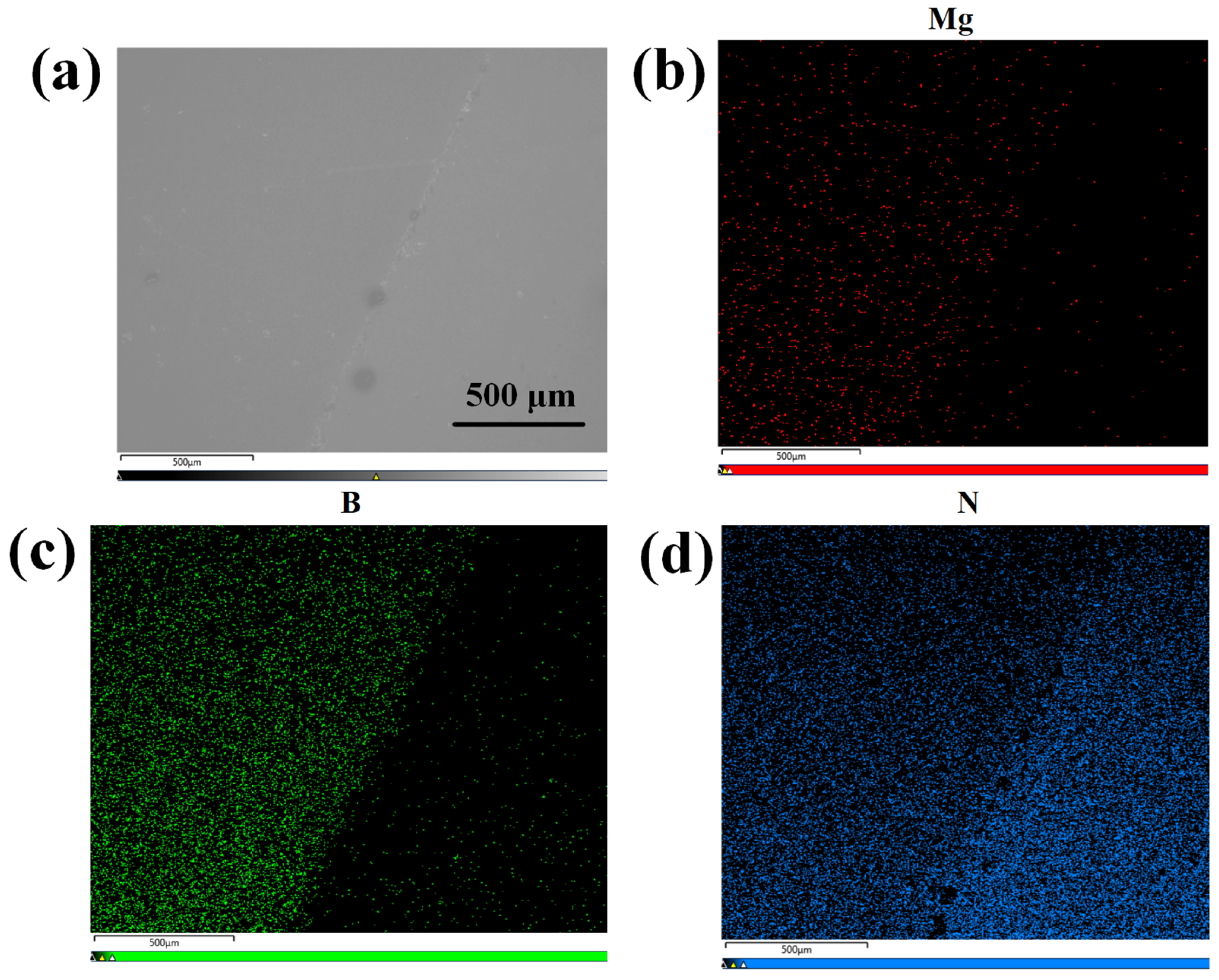Improvement of GaN-Based Device Performance by Plasma-Enhanced Chemical Vapor Deposition (PECVD) Directly Preparing h-BN with Excellent Thermal Management Characteristics
Abstract
:1. Introduction
2. Materials and Methods
3. Results and Discussion
- Ultrasonic cleaning in deionized water twice (each for 10 min);
- Rapid thermal annealing (RTA) treatment at 500 °C for 10 min under a N2 atmosphere;
- Ultrasonic cleaning in isopropanol and deionized water (10 min each), followed by drying with N2 blowing.
4. Conclusions
Author Contributions
Funding
Institutional Review Board Statement
Informed Consent Statement
Data Availability Statement
Conflicts of Interest
References
- Mishra, U.K. Gallium Nitride Versus Silicon Carbide: Beyond the Switching Power Supply. Proc. IEEE 2023, 111, 322–328. [Google Scholar] [CrossRef]
- Rahman, K.F.; Falina, S.; Mohamed, M.F.P.; Kawarada, H.; Syamsul, M. The role of gallium nitride in the evolution of electric vehicles: Energy applications, technology, and challenges. Appl. Phys. Rev. 2024, 11, 031322. [Google Scholar] [CrossRef]
- Zheng, Y.; Sun, C.; Xiong, B.; Wang, L.; Hao, Z.; Wang, J.; Han, Y.; Li, H.; Yu, J.; Luo, Y. Integrated gallium nitride nonlinear photonics. Laser Photonics Rev. 2022, 16, 2100071. [Google Scholar] [CrossRef]
- Shen, G.; Zhu, H.; Zeng, D.; Xue, Q.; Che, W. A Ka-band high-power switchable filtering power combiner MMIC in 100-nm GaN-on-Si. IEEE Trans. Ind. Electron. 2021, 69, 10467–10477. [Google Scholar] [CrossRef]
- Zheng, H.X.; Lee Sanchez, W.A.; Lin, K.L.; Horng, R.H. Investigation of Gallium Nitride Based HEMTs with Thermal Dissipation. Adv. Electron. Mater. 2024, 10, 2400202. [Google Scholar] [CrossRef]
- Kang, J.S.; Li, M.; Wu, H.; Nguyen, H.; Aoki, T.; Hu, Y. Integration of boron arsenide cooling substrates into gallium nitride devices. Nat. Electron. 2021, 4, 416–423. [Google Scholar] [CrossRef]
- Lundh, J.S.; Chatterjee, B.; Song, Y.; Baca, A.G.; Kaplar, R.J.; Beechem, T.E.; Allerman, A.A.; Armstrong, A.M.; Klein, B.A.; Bansal, A. Multidimensional thermal analysis of an ultrawide bandgap AlGaN channel high electron mobility transistor. Appl. Phys. Lett. 2019, 115, 153503. [Google Scholar] [CrossRef]
- Wu, D.; Ding, H.; Fan, Z.-Q.; Jia, P.-Z.; Xie, H.-Q.; Chen, X.-K. High interfacial thermal conductance across heterogeneous GaN/graphene interface. Appl. Surf. Sci. 2022, 581, 152344. [Google Scholar] [CrossRef]
- Han, N.; Viet Cuong, T.; Han, M.; Deul Ryu, B.; Chandramohan, S.; Bae Park, J.; Hye Kang, J.; Park, Y.-J.; Bok Ko, K.; Yun Kim, H. Improved heat dissipation in gallium nitride light-emitting diodes with embedded graphene oxide pattern. Nat. Commun. 2013, 4, 1452. [Google Scholar] [CrossRef]
- Zhang, J.; Kong, X.; Wang, Y.; Zhang, Z.; Li, L.; Xu, K.; Li, M.; Yang, R.; Zhou, Y.; Cai, T. Recycled and flexible boron nitride heat spread film with high thermal conductivity. J. Mater. Chem. C 2023, 11, 13204–13212. [Google Scholar] [CrossRef]
- Yan, Q.; Dai, W.; Gao, J.; Tan, X.; Lv, L.; Ying, J.; Lu, X.; Lu, J.; Yao, Y.; Wei, Q. Ultrahigh-aspect-ratio boron nitride nanosheets leading to superhigh in-plane thermal conductivity of foldable heat spreader. ACS Nano 2021, 15, 6489–6498. [Google Scholar] [CrossRef] [PubMed]
- Wu, Z.; Shen, H.; Wang, Y.; Jiao, L.; Chen, Y.; Gong, X.; Lin, M. Enhancing mechanical property, thermal conductivity, and radiation stability of fluorine rubber through incorporation of hexagonal boron nitride nanosheets. Polym. Compos. 2024, 45, 11659–11672. [Google Scholar] [CrossRef]
- Yun, H.; Kwak, M.-G.; Park, K.; Kim, Y. Fabrication, thermal conductivity, and mechanical properties of hexagonal-boron-nitride-pattern-embedded aluminum oxide composites. Nanomaterials 2022, 12, 2815. [Google Scholar] [CrossRef]
- Tang, Y.; Zhang, P.; Zhu, M.; Li, J.; Li, Y.; Wang, Z.; Huang, L. Temperature effects on the dielectric properties and breakdown performance of h-BN/epoxy composites. Materials 2019, 12, 4112. [Google Scholar] [CrossRef]
- Dai, W.; Wang, Y.; Li, M.; Chen, L.; Yan, Q.; Yu, J.; Jiang, N.; Lin, C.T. 2D Materials-Based Thermal Interface Materials: Structure, Properties, and Applications. Adv. Mater. 2024, 36, 2311335. [Google Scholar] [CrossRef] [PubMed]
- Zhang, G.; Wu, H.; Zhang, L.; Yang, L.; Xie, Y.; Guo, F.; Li, H.; Tao, B.; Wang, G.; Zhang, W. Two-Dimensional Van Der Waals Topological Materials: Preparation, Properties, and Device Applications. Small 2022, 18, 2204380. [Google Scholar] [CrossRef]
- Tian, S.; Pan, Q.; Li, H.; Sui, X.; Chen, Y. Two-dimensional material membrane fabrication: Progress and challenges. Curr. Opin. Chem. Eng. 2023, 39, 100900. [Google Scholar] [CrossRef]
- Chen, M.-W.; Kim, H.; Bernard, C.; Pizzochero, M.; Zaldívar, J.; Pascual, J.I.; Ugeda, M.M.; Yazyev, O.V.; Greber, T.; Osterwalder, J. Electronic properties of transferable atomically thin MoSe2/h-BN heterostructures grown on Rh (111). ACS Nano 2018, 12, 11161–11168. [Google Scholar] [CrossRef]
- Wang, R.; Purdie, D.G.; Fan, Y.; Massabuau, F.C.-P.; Braeuninger-Weimer, P.; Burton, O.J.; Blume, R.; Schloegl, R.; Lombardo, A.; Weatherup, R.S. A peeling approach for integrated manufacturing of large monolayer h-BN crystals. ACS Nano 2019, 13, 2114–2126. [Google Scholar] [CrossRef]
- Binder, J.; Dabrowska, A.K.; Tokarczyk, M.; Rousseau, A.; Valvin, P.; Bozek, R.; Nogajewski, K.; Kowalski, G.; Pacuski, W.; Gil, B. Homoepitaxy of Boron Nitride on Exfoliated Hexagonal Boron Nitride Flakes. Nano Lett. 2024, 24, 6990–6996. [Google Scholar] [CrossRef]
- Sunny, A.; Balapure, A.; Ganesan, R.; Thamankar, R. Room-Temperature Deep-UV Photoluminescence from Low-Dimensional Hexagonal Boron Nitride Prepared Using a Facile Synthesis. ACS Omega 2022, 7, 33926–33933. [Google Scholar] [CrossRef] [PubMed]
- Behura, S.; Nguyen, P.; Debbarma, R.; Che, S.; Seacrist, M.R.; Berry, V. Chemical interaction-guided, metal-free growth of large-area hexagonal boron nitride on silicon-based substrates. ACS Nano 2017, 11, 4985–4994. [Google Scholar] [CrossRef] [PubMed]
- Chen, T.A.; Chuu, C.P.; Tseng, C.C.; Wen, C.K.; Li, L.J. Wafer-scale single-crystal hexagonal boron nitride monolayers on Cu(111). Nature 2020, 579, 219–223. [Google Scholar] [CrossRef] [PubMed]
- Wang, J.; Xu, T.; Wang, W.; Zhang, Z. Miracle in “White”: Hexagonal Boron Nitride. Small 2024, 2400489. [Google Scholar] [CrossRef]
- Takeuchi, K.; Ogura, H.; Hasuike, N.; Kamikawa, T. Decomposition of the anisotropic strain in 3D-structure GaN layers using Raman spectroscopy. Sci. Rep. 2024, 14, 3330. [Google Scholar] [CrossRef]
- Cai, J.; Jolie, W.; Silva, C.C.; Petrović, M.; Schlueter, C.; Michely, T.; Kralj, M.; Lee, T.-L.; Busse, C. Modifying the geometric and electronic structure of hexagonal boron nitride on Ir (111) by Cs adsorption and intercalation. Phys. Rev. B 2018, 98, 195443. [Google Scholar] [CrossRef]
- Kim, S.-K.; Cho, H.; Kim, M.J.; Lee, H.-J.; Park, J.-h.; Lee, Y.-B.; Kim, H.C.; Yoon, C.W.; Nam, S.W.; Kang, S.O. Efficient catalytic conversion of ammonia borane to borazine and its use for hexagonal boron nitride (white graphene). J. Mater. Chem. A 2013, 1, 1976–1981. [Google Scholar] [CrossRef]
- Bouazizi, H.; Bouzidi, M.; Chaaben, N.; El Gmili, Y.; Salvestrini, J.; Bchetnia, A. Observation of the early stages of GaN thermal decomposition at 1200 °C under N2. Mater. Sci. Eng. B 2018, 227, 16–21. [Google Scholar] [CrossRef]
- Demirci, U.B. Mechanistic insights into the thermal decomposition of ammonia borane, a material studied for chemical hydrogen storage. Inorg. Chem. Front. 2021, 8, 1900–1930. [Google Scholar] [CrossRef]
- Meng, J.; Chen, J.; Wang, G. Low-Temperature Direct Growth of Few-Layer Hexagonal Boron Nitride on Catalyst-Free Sapphire Substrates. ACS Appl. Mater. Interfaces 2022, 14, 7004–7011. [Google Scholar] [CrossRef]
- Balandin, A.A.; Ghosh, S.; Bao, W.; Calizo, I.G.; Teweldebrhan, D.B.; Miao, F.; Lau, C.N. Extremely High Thermal Conductivity of Graphene: Experimental Study. arXiv 2008, arXiv:0802.1367. [Google Scholar] [CrossRef]
- Lax, M. Temperature rise induced by a laser beam. J. Appl. Phys. 1977, 48, 3919–3924. [Google Scholar] [CrossRef]
- Wang, L.; Jie, J.; Shao, Z.; Zhang, Q.; Zhang, X.; Wang, Y.; Sun, Z.; Lee, S.T. MoS2/Si heterojunction with vertically standing layered structure for ultrafast, high-detectivity, self-driven visible-near infrared photodetectors. Adv. Funct. Mater. 2015, 25, 2910–2919. [Google Scholar] [CrossRef]
- Lu, Y.; Wu, Z.; Xu, W.; Lin, S. ZnO quantum dot-doped graphene/h-BN/GaN-heterostructure ultraviolet photodetector with extremely high responsivity. Nanotechnology 2016, 27, 48LT03. [Google Scholar] [CrossRef]
- Peng, Y.; Yang, Y.; Xiao, K.; Yang, Y.; Ding, H.; Deng, J.; Sun, W. Direct Synthesis of Vertical Self-Assembly Oriented Hexagonal Boron Nitride on Gallium Nitride and Ultrahigh Photoresponse Ultraviolet Photodetectors. Nanomaterials 2023, 13, 1546. [Google Scholar] [CrossRef]












| Sample | Deposition Temperature (°C) | RF Power (W) | Deposition Time (Min) |
|---|---|---|---|
| A1 | 900 | 100 | 30 |
| A2 | 1100 | 100 | 30 |
| A3 | 1100 | 100 | 5 |
| B1 | 500 | 0 | 30 |
| B2 | 700 | 0 | 30 |
| B3 | 900 | 0 | 30 |
| B4 | 1100 | 0 | 30 |
| B5 | 1100 | 0 | 45 |
| B6 | 1100 | 0 | 60 |
| C1 | 900 | 400 | 30 |
| C2 | 1100 | 400 | 30 |
| Sample | dω/dT (cm−1/°C) E2 (High) (GaN) | dω/dP (cm−1/mW) E2 (High) (GaN) | Thermal Conductivity K (W·m−1 K−1) |
|---|---|---|---|
| GaN | 0.011 | 0.191 | 218 |
| A2 | 0.021 | 0.082 | 743 |
| Sample | A1 | A2 | C1 | C2 |
|---|---|---|---|---|
| Thermal Conductivity K (W·m−1 K−1) | 369 | 743 | 201 | 432 |
| References | Structure | Thermal Conductivity K (W·m−1 K−1) | Detectivity D* (Jones) | Responsivity R (mA/W) |
|---|---|---|---|---|
| Lu et al. Nanotechnology 2016, 27, 48LT03 [34] | ZnO quantum dot-doped graphene/ h-BN/GaN | / | 1.0 × 1013 (248 nm) | 1915 (248 nm) |
| Peng et al. Nanomaterials 2023, 13, 1546 [35] | h-BN (hole):/ GaN:Si | 425 | 2.6 × 1013 (280 nm) | 1970.7 (280 nm) |
| This study | h-BN:Mg/ GaN:Si | 743 | 3.2 × 1013 (280 nm) | 3875.8 (280 nm) |
Disclaimer/Publisher’s Note: The statements, opinions and data contained in all publications are solely those of the individual author(s) and contributor(s) and not of MDPI and/or the editor(s). MDPI and/or the editor(s) disclaim responsibility for any injury to people or property resulting from any ideas, methods, instructions or products referred to in the content. |
© 2025 by the authors. Licensee MDPI, Basel, Switzerland. This article is an open access article distributed under the terms and conditions of the Creative Commons Attribution (CC BY) license (https://creativecommons.org/licenses/by/4.0/).
Share and Cite
Peng, Y.; Liu, L.; Xu, Q.; Luo, Y.; Bai, J.; Xie, X.; Wei, H.; Wei, W.; Xiao, K.; Sun, W. Improvement of GaN-Based Device Performance by Plasma-Enhanced Chemical Vapor Deposition (PECVD) Directly Preparing h-BN with Excellent Thermal Management Characteristics. Molecules 2025, 30, 1307. https://doi.org/10.3390/molecules30061307
Peng Y, Liu L, Xu Q, Luo Y, Bai J, Xie X, Wei H, Wei W, Xiao K, Sun W. Improvement of GaN-Based Device Performance by Plasma-Enhanced Chemical Vapor Deposition (PECVD) Directly Preparing h-BN with Excellent Thermal Management Characteristics. Molecules. 2025; 30(6):1307. https://doi.org/10.3390/molecules30061307
Chicago/Turabian StylePeng, Yi, Lingyun Liu, Qingfeng Xu, Yuqiang Luo, Jianzhi Bai, Xifeng Xie, Huanbing Wei, Wenwang Wei, Kai Xiao, and Wenhong Sun. 2025. "Improvement of GaN-Based Device Performance by Plasma-Enhanced Chemical Vapor Deposition (PECVD) Directly Preparing h-BN with Excellent Thermal Management Characteristics" Molecules 30, no. 6: 1307. https://doi.org/10.3390/molecules30061307
APA StylePeng, Y., Liu, L., Xu, Q., Luo, Y., Bai, J., Xie, X., Wei, H., Wei, W., Xiao, K., & Sun, W. (2025). Improvement of GaN-Based Device Performance by Plasma-Enhanced Chemical Vapor Deposition (PECVD) Directly Preparing h-BN with Excellent Thermal Management Characteristics. Molecules, 30(6), 1307. https://doi.org/10.3390/molecules30061307






